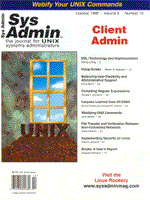
Sidebar 1: Key TerminologyADSL -- Asymmetric Digital Subscriber Line. A modem technology that allows up to 8 Mbps downstream and 1.5 Mbps upstream. ANSI -- American National Standards Institute. Accredits and implements standards. Member of International Standards Organization. ATM -- Asynchronous Transfer Mode. A high-bandwidth, low-delay, connection-oriented switching and multiplexing technique using fixed-sized cells. Attenuation -- The dissipation of the power of a transmitted signal as it travels over a wire. ATU-C -- ADSL transmission unit in CO. It refers to ADSL modems housed in DSLAMs. ATU-R -- ADSL transmission unit in remote (customer) locations. It refers to ADSL CPE. AWG -- American Wire Gauge. An indication of wire size. The heavier the gauge, the lower the AWG number and the lower the impedance. For example, a 24 AWG wire has a diameter of 1/24". Outside of North America, wire gauges are referred by their diameter in millimeter. Bridge tap -- Any part of the local loop that is not in the direct transmission path between the CO and the service user. CAP -- Carrierless Amplitude and Phase Modulation. A transmission technology based on quadrature amplitude modulation for implementing a DSL connection. Carrier signal is suppressed before transmission and is re-assembled in receiving modem. CLEC -- Competitive Local Exchange Carrier. A service provider that competes with the local RBOC or Incumbent Local Exchange Service/provider (ILEC). CO -- Central office. A facility that contains the lowest node in the hierarchy of switches that comprise the public telephone network. CPE -- Customer Premises Equipment. A piece of equipment that sits in a customers home or business location. Crosstalk -- The effect of transmission signals on a copper wire on an another wire in close physical proximity. Crosstalk has negative impact on transmission signals. DLC -- Digital Loop Carrier. Network transmission equipment, consisting of a CO terminal and a remote terminal, used to provide a pair gain function in a remote location outside of a CO. DMT -- Discrete MultiTone. An ADSL technology using digital signal processors to divide the signal into 256 subchannels from 64 kHz to 1.1 MHz. DSLAM -- Digital Subscriber Line Access Multiplexer. A concentrating platform for DSL modems that provides high-speed data transmission and optional POTS service simultaneously over traditional twisted-pair wiring. E1 -- A wideband digital interface operating at 2.048 Mbps, as defined by the ITU recommendations G.703 and G.704. Generally available outside North America. Echo Cancellation -- A technique used in DSL to cancel signal interference due to echo of the original transmitted signal. FDM -- Frequency division multiplexing. A technique that divides the available bandwidth of a channel into a number of separate channels. FEXT -- Far End Crosstalk. One category of crosstalk that occurs at the remote end of a link. G.Lite -- A splitterless ADSL standard that eases installation at a subscriber's site. It is also called DSL-Lite. Maximum speed is 1.5 Mbps downstream and 384 Kbps upstream. HDSL -- High-bit-rate Digital Subscriber Line. A technique for high-bandwidth, bidirectional transmission over copper wire for T1 and E1 lines. IDSL -- ISDN DSL. Uses 2B1Q line code. ILEC -- Incumbent Local Exchange Carrier. Refers to the primary existing central office carrier, as distinguished from new competitive carriers established after deregulation. ISDN -- Integrated Services Digital Network. Telecommunication service that uses digital transmission and switching technology to provide voice and data communications on a bearer channel while sending signaling on a data channel. ISP -- Internet Service Provider. A vendor who provides direct access to the Internet IXC -- Inter-exchange carrier. A company that provides inter-LATA (local access transport area) telecommunications services (long-distance carrier). LEC -- Local Exchange Carrier. A company that provides intra-LATA (local access transport area) telecommunications services. Local loop -- The distance between the CO and the customer premises. It is also called the last mile. NEXT -- Near End Crosstalk. Crosstalk in which the interfering signal is traveling in the opposite direction as the desired signal. POP -- Point-of-presence. A service provider's (IXC, ISP) equivalent of a CO. POTS -- Plain Old Telephone Service. Standard telephone service over the PSTN, with an analog bandwidth of less than 4 kHz. PPP -- Point-to-point protocol. A standard-based protocol commonly used in wide areas to provide lower layer transport. PSTN -- Public switched telephone network. A telephone system through which users can be connected by dialing specific telephone numbers. PVC -- Permanent Virtual Circuit. A virtual connection established administratively. Included in networks supporting ATM, Frame Relay, and X.25. RADIUS -- Remote Authentication Dial-In User Service. A standard-based protocol/service on a centralized server to authenticate remote dial-in users. RBOC -- Regional Bell Operating Company. The term used for the leading telephone service providers in North America. These include Ameritech, Bell Atlantic, BellSouth, SBC and US West. SDSL -- Symmetric Digital Subscriber Line. Is used often for symmetric T1/E1 speeds of 1.544/2.048Mbps. Self NEXT -- The NEXT caused by like loops in the same cable binder. Splitter -- A device used to separate POTS frequency from DSL frequency. SVC -- Switched virtual circuit. The circuit is created on demand. T1 -- A term for a digital carrier facility (T carrier) used to transmit a DS1 (Digital Signal level 1) formatted digital signal at 1.544 Mbps. It is primarily used in the United States. VDSL -- Very high bit rate DSL. Generally refers to a data transmission speed from 25 to 50+ Mbps over very short distances. xDSL -- Refers to all DSL-based services. |